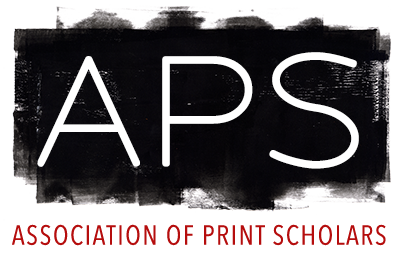No sidebar for this page. Contact administrator
Article
Posted: 06/02/2015
Pierre Juhel.
"La Société pour l’Etude de la Gravure Française (1911-1914)."
Nouvelles de l'estampe
(July 2007): 26-30.
Article
Posted: 05/27/2015
Britany Salsbury.
"Wallpaper at the Cooper-Hewitt."
Print Quarterly
32, no. 2 (2015): 228-230.
Relevant research areas:
North America,
Western Europe,
18th Century,
19th Century,
20th Century,
Contemporary,
Engraving,
Etching,
Lithography,
Relief printing,
Screenprinting
Article
Posted: 05/12/2015
Maureen Warren.
"William Hogarth’s Four Stages of Cruelty and Moral Blindness."
Athanor
(July 2010): 17-27.
Article
Posted: 05/05/2015
Simon Turner.
"The Equestrian Portrait Prints of Wenceslaus Hollar."
Art in Print
5, no. 1 (May 2015): 17-26.
Article
Posted: 05/04/2015
Elizabeth Savage (Upper).
"New Evidence of Erhard Ratdolt’s Working Practices: The After-Life of Two Red Frisket-Sheets from the Missale speciale Constantiense (1505)."
Journal of the Printing Historical Society
(2015).
Article
Posted: 05/04/2015
Elizabeth Savage (Upper).
"Flying Colours."
Apollo Magazine
(July 2014): 44-49.
Colour has never been so popular. Recent and current shows have celebrated it around the world, demonstrating a new interest in its appeal on the part of art historians, curators and collectors. So has the bias against ‘colore’, rumbling on since the Renaissance, finally been conquered?
Article
Posted: 05/04/2015
Elizabeth Savage (Upper).
"Red Frisket Sheets, c. 1490-1700: The Earliest Artefacts of Colour Printing in the West."
Papers of the Bibliographical Society of America
108, no. 4 (December 2014): 477-522 .
The earliest published instructions for printing text in colors (red and black) famously appeared in Joseph Moxon’s Mechanick Exercises (1683), over two hundred years after text had first been printed in color in some copies of the Gutenberg Bible (c.1457). Due to the absence of written information, the understanding of the earliest color printing techniques and methods was based on the analysis of the printed material itself.
This changed in 2000, when Margaret Smith described a fragment of a frisket sheet (a mask that protects unprinted areas of a sheet from stray ink) that was used to print selected text in red in the early sixteenth century. This complex object, a manuscript leaf that was re-used first as a frisket sheet for printing selected text in red in one book and then in the pasteboard in the binding of another, is the earliest artifact of any color printing process in the West.
This paper presents two dozen other early modern frisket sheets for color printing that have recently been identified. As they were used over a period of almost 150 years across several countries, it argues that their common features revise the understanding of common workshop practices for early color printing in both Bibliography and Art History. It proposes that their tripartite material history points to a previously unknown cycle of the exchange of materials within the book trade across early modern Europe. Finally, it suggests that these chance survivals are not as rare as they seem.
Article
Posted: 05/04/2015
Elizabeth Savage (Upper),
Ad Stijnman.
"Color Prints before Erhard Ratdolt: Engraved Paper Instruments in Lazarus Beham’s Buch von der Astronomie (Cologne: Nicolaus Götz, c. 1476)."
Gutenberg-Jahrbuch
89 (2014): 86-105.
The fifteenth-century origins of color printmaking have largely been neglected in both the history of the book and the history of art. After a brief but fertile period of research waned around 1910, only a few more incunable color prints have come to light. The known corpus consists of some monochrome and bi-color printed type, initials and printers’ devices; several monochrome copper engravings; and many of the multi-color woodcut illustrations that Erhardt Ratdolt (active in Venice c.1474–86 and in Augsburg 1486–1527/8) published from the 1480s. This article documents for the first time two incunable engravings that were printed in color to illustrate the so-called Buch von der Astronomie (c. 1476) issued by the innovative printer Nicolaus Götz (active in Cologne 1474–80). One survives in monochromatic impressions in black and in red and the other survives in monochromatic black and various bi-color combinations of red and black. They demonstrate that multi-color prints, color-printed book illustrations, and color-printed intaglio designs first appeared in an earlier decade than has been realized. By reconstructing the techniques of their production, this article offers new insights into both the role of color in early printing projects and the combination of intaglio printmaking with typography. The findings contribute to current research trends exploring the earliest development and dissemination of color printmaking techniques in the history of art, the history of science and the history of the book.
Article
Posted: 04/26/2015
Alison Chang.
"Object Lesson: Otherness on Display in Max Beckmann’s Annual Fair."
Manual: a journal about art and its making
(September 2014).
Article
Posted: 04/09/2015
Katherine Alcauskas.
"Social Surrealism: David Smith’s Women in War."
Yale University Art Gallery Bulletin
2011 (2012): tbd.
